Brian Florian
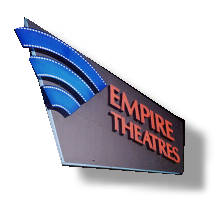 |
Empire Theatres 120 theaters in 4 Canadian maritime provinces Manned by employees extraordinare Lots of great movies day in and day out Dolby Digital, DTS, SDDS, and even Dolby Stereo Great picture quality and sound guaranteed |
It's no secret that I really love going to the movies. Unlike the vast majority of home theater buffs, I did not have that moment where I declared that movies are just as good or better at my house than at the theater. Even when (or more like IF) I manage to get a video projector in my house, I'm not sure it will be able to top the sheer awe of a really big screen. And speaking of "how the director intended", this is the venue they still have in mind for their work. Maybe I've just been blessed with a good local Multiplex that keeps up with technology and cares a lot about a quality presentation.
When circumstances lead to my being invited to spend time in the projection room of our local movie complex, I didn't need to be asked twice. Empire Theaters has been in operation since 1978 and runs screens across the four maritime provinces. I was met at the door by Empire's head Projectionist and Sound Engineer Francis Casey.
"I'm responsible for 120 screens throughout the Maritimes . . . so I move around a lot." "Wow," I thought. 120 screens is a lot to keep track of, but Francis seems to know each location well, telling me about the different technologies and future plans they have for each spot.
But before we go upstairs, one has to stop
and ponder the sheer magnitude of running a theater.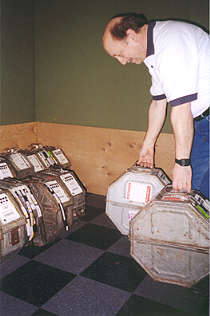 Staffing,
supplies for the concessions, upcoming releases, incoming releases,
are the bathrooms clean? Ads for the newspaper, what time to
run which movie at, which one to put in what theater, did we
recalibrate screen 7? And you thought your remote control was
hard to operate!
Staffing,
supplies for the concessions, upcoming releases, incoming releases,
are the bathrooms clean? Ads for the newspaper, what time to
run which movie at, which one to put in what theater, did we
recalibrate screen 7? And you thought your remote control was
hard to operate!
As we made our way past the "Staff Only" door and up a steep and narrow staircase, I got the feeling I was about to enter the inner sanctum of a secret society. Suddenly, there it was, the object of my search: a Dolby Digital equipped 35mm projector and sound equipment rack. But first have a closeup look at the medium: a piece of a 35mm film strip (photo below). As Francis sat beside me, eating his pie for dinner, he showed me the various sound formats present on the film. "In the beginning," he said, "we would get prints in one format or another depending on a director or studio's preference, but thankfully just about ever release now is in this sort of multi-format print, so if our biggest screen is equipped with one format, we can run the current hit there regardless."
Films arrive in these metal cans on "20-minute reels" and then are taken to the cutting table. After Francis examines the print for sound information, they are transferred to larger reels which finally get rolled over to the projectors.
Most folks remember when each screen had at least two projectors with small reels. When the short reel on one was over, the projectionist would quickly kick in the second projector with the next segment of the movie, and the show would go on. This system had the potential to hiccup a presentation but more importantly was hard on film, being wound and re-wound over and over.
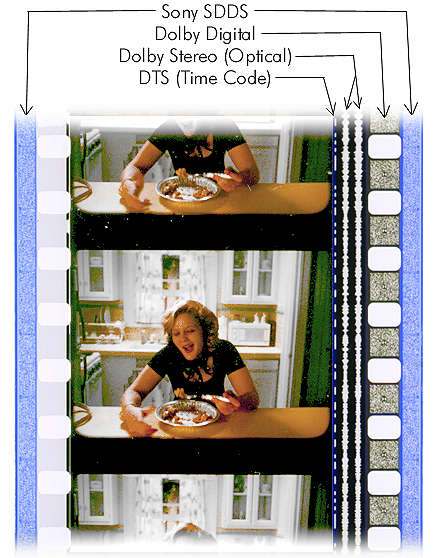 |
 |
Today's theaters use these huge platters like the ones you see Francis giving a last minute inspection to. This is where an evening's presentation gets assembled, working from the inside out. First some blank leader is put on, followed by the "Coming Attractions" trailer, then the previews themselves etc., until the whole show is one long piece. When I asked how long of a program one platter would hold, Francis told me, "I'm not sure. I've never actually filled one with just one movie. We did push the limit once with a double feature, and that was nearly 4 hours."
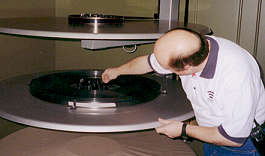 |
 |
The film comes off the platter in a similar fashion to the way an 8-track would play: from the center out. If you look at the closeup photo of the platter above, you can see the stationary feed mechanism at the center. A sensor on the feeder picks up how the film is being pulled by the projector and controls the rotation of the great platter around the mechanism as necessary to keep the film feeding properly. The film passes through the various sound hardware and advance mechanisms and is taken up by one of the other platters, above or below, ready for the next show.
The Regent Mall Cinemas is comprised of ten screens. Three are fitted with the Dolby Digital equipment we'll get into later. One is outfitted for Sony 8 Channel SDDS. All have Dolby Stereo capability (optical two channel tracks decoded for Dolby Stereo) and are equipped with a mixture of Dolby DP45 and Ultra Stereo JS 200 analog processors. Also they can be hooked up to a roaming DTS decoder.
Each room features the same Strong 35mm projection system fitted at a slight downward angle. Inside each projector is a 2,000 watt arc lamp seen here. These generate so much heat that cool air is constantly brought up from underneath and pulled through by fans in ductwork at the top. If you look at the open door you can see the inspection hole that I got to peek through while a film was running. This is not at all unlike looking through a welder's helmet at an electric arc.
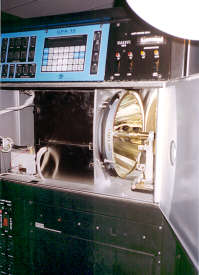 |
On the top you can see the control pad for the projector's CPA10 computer. This is no ordinary control system. It can be configured with 10 different programs. Each can be set to start at any time of day and can include things like trigger the lights down and bring them up again. It can even select sound formats and change projector lenses! |
35mm films are distributed generally in one of two aspect ratios. These are roughly 1.85:1 and 2.35:1, referred to by those in the loft as "flat" and "scope" respectively, each requiring a different projection lens. The Strong system has a motorized radial lens system that can be controlled by the on board computer. By using a piece of foil tape, it can change lenses between, say, a flat trailer and a scope movie. "Once this is set-up, it's really automatic", I mumbled. "Yup", Francis said, munching the last bite of apple pie.
| Next, let's look at the basic film path (see photo on the right). From the big platters, the film is fed up and around through pulleys. If it is a digital audio system, the reader for the format is perched on top of the projector and is the first thing to see the film. Next comes the shutter and intermittent unit. Films are distributed for projection at 24 frames per second. The intermittent unit pauses each frame of film in front of the shutter for projection. The shutter is a rotating pair of blades, like a light valve, which flashes light 48 times per second on the film. So each frame gets not one but two flashes of light to produce the flicker free presentation we are accustomed to. Beneath this system is the projector's own optical analog sound pickup. A light is projected through the two traces and a photo pickup feeds almost directly to a preamp and then along to the audio rack. After this, the film is routed back to the platters for take-up. |
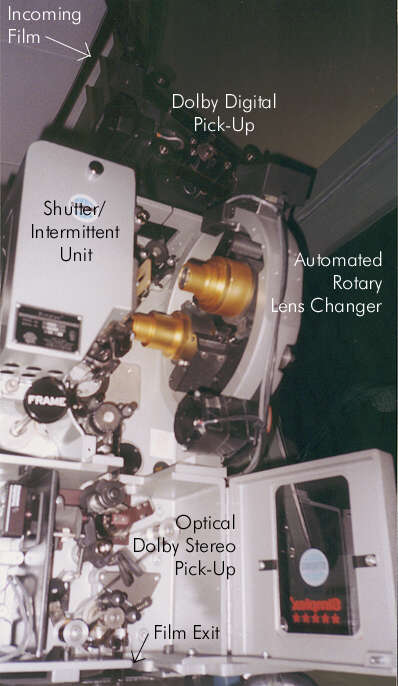 |
As I mentioned, for any of the digital formats, a separate reader is installed in the film path just before feeding into the projector. Here we see Dolby's model (photo at right, below). Light is shone through a light pipe, passed through the optical digital track and "scanned" by a CCD. Looking back at the clasp of the film clip, you can see the Dolby Digital data are located between each sprocket hole (note the copyrighted trademark double D in each square). Each little piece is a "picture" made up of 76x76 "fixels" (film elements) These get translated into audio data, synchronization, error correction, and auxiliary data. The captured data are put through extensive DSP and sent by wire over to the sound rack.
 |
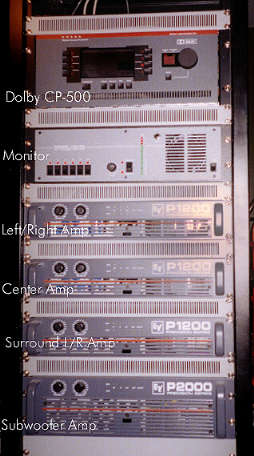 |
Both the digital and stereo analog signals are fed to the Dolby CP-500 Cinema processor. Here is where we start to see one or two similarities with our home equipment. The CP-500 has doubled inputs (for classic multi-projector installations) for Digital, Analog, and a couple for what was are commonly called "non-sync" inputs (in layman's terms: house music, PA system, etc.) Not all that different in function from your Dolby Digital Preamp/Receiver. Internally though, most of these components are very modular, consisting of a back-plane and interchangeable boards.
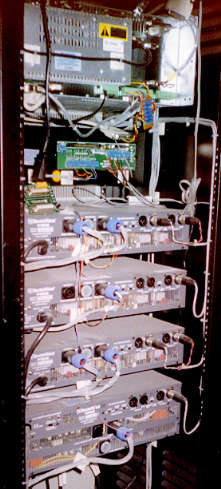 |
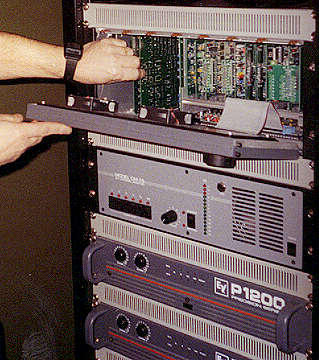 |
The processor can decode and properly present Dolby Digital, Dolby Stereo SR, Dolby Stereo, and even mono. It is a very sophisticated piece of equipment, able to dynamically revert from one format to another, from say the digital track to the backup analog should there be a problem with the film. Dolby uses a rather large backlit LCD screen for all setup and operation including the three front 27-band 1/3 octave EQs and the two 12-band full octave EQs for the rears. This feature is preferred as it does not require an external PC for adjustment. The large knob on the right is the master fader. "We use a special 4 microphone arrangement in the theater to calibrate the system," Francis explained. "These can feed the CP-500's own 1/3 octave real time analyzer, but I still prefer to use my THX approved R2 analyzer. The CP-500 generates its own pink-noise test tones that we use to set each channel to 85 dB and an ISO 2969 response (flat up to 2 kHz and then rolled off at 3 dB per octave). This produces a perceived flat response in an auditorium." "What happens from there is up to the director," I laughed. "Yes," he replied. "These days they are making them so loud that in answer to patron complaints, we have often had to turn the fader from say a 7 to a 5.5, and it's usually because trailers have compressed soundtracks which can sound irritating." "Do you ride the gain for trailers," I asked. "Well, we can actually program the CP-500 for a different fader setting for the different sound formats. It's a losing battle though because most trailers are in digital now too. Plus, what if the system has to revert to the analog tracks? In most theaters we just back off a little." Francis further explained that Dolby has developed a new way to measure sound in terms of subjective loudness which they are encouraging studios and directors to use. This would ensure that directors achieve the impact that they seek without undue stress to the audience. For more detailed information on the topic of loudness, you can read the excellent paper by loan Allen of Dolby at www.dolby.com/tech/toolouds.pdf.
From the processor, we go to the EV amplifiers. "We're talking 550 watts per channel into 4 Ohms and a mono-bridged unit giving about 1,500 watts to the sub," Francis told me. "We use EV TS940D speakers. These are dual 15" cones and a small horn. The subs are twin 18" drivers. We've also used JBL in other installations, and I've found both to be quite good."
On a panel between the CP-500 and the amplifiers is a sound monitor. The single speaker can listen in on any combination of the six channels, monitor either the output of the processor or the output of the amplifiers. From this vantage point, the projectionist can hear almost any problem in the sound chain, except for the theater speakers themselves.
Looking behind the system (photo above, left), we see some of the connections. Most of the inputs on the CP-500 are DB-25 or DB-9. Outputs are on screw terminals from which XLR type outputs to the various amplifiers can be seen.
Onward we walked until we came to the SDDS system consisting of a DFP-R2000 reader and DFP-D2000 decoder. Because of its 8-channel capability (5 front channels), Empire naturally puts this one on the largest screen in the house. The pickup is very similar "but just different enough," Francis remarked. "They don't want us using it for anything but SDDS." Because the backup track is always Dolby Stereo, a separate analog processor - in this case an Ultra Stereo - is used here. If there is a problem with the digital track, the SDDS processor automatically goes to bypass and passes along the six channels of input from the analog processor. Setup and adjustments are performed with a PC using Windows software connected via the serial port. Shown below, left, is a PC screen shot (copyright Sony SDDS) of one of the eight 28-band 1/3 octave EQs. The remainder of the rack, monitor and amplifiers were pretty much the same all around.
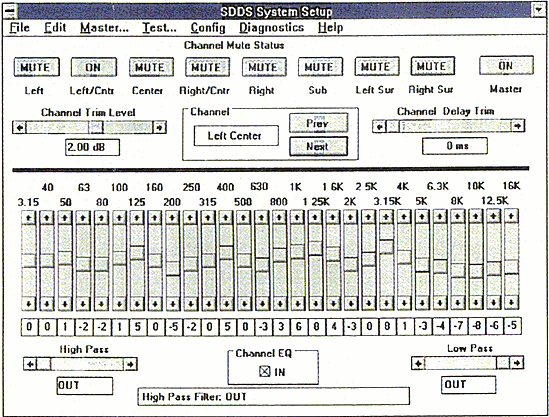 |
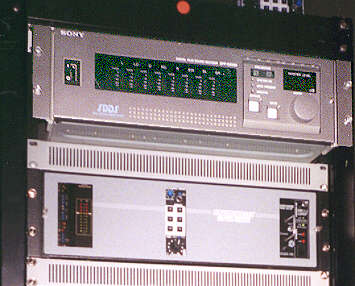 |
Lastly we came to the DTS rack, a DTS-6D.
DTS film only contains an optical time code which is still read
by a special pickup ahead of the projector. The sound data itself
is stored on very special CDs like the one for "The Matrix"
which I watched Francis prepare for opening night. The DTS processor
has three drives to load the discs (a typical movie uses two
discs, so the third one could contain digital audio for trailers).
The time code is very particular. You can't play the CD from
one title with the film from another, so there is no need to
worry about hearing the soundtrack of last week's movie with
this one's new release. This rack again had an Ultra Stereo analog
processor for backup. Setup and adjustment are slightly
different from DD and SDDS.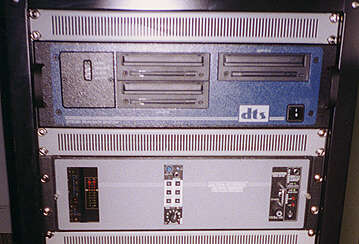
Which of the three sound formats is the best? "They're so very close in sound quality," Francis said, "but, if anything, the Dolby system is a little more accommodating for us as theater operators."
"So what's next?" I asked. "We're looking at making a few changes to this location like increasing the angle of the floor, adding more acoustic treatments to the walls, and improving the sound proofing between theaters to be closer to the ideal. Then of course there's Dolby Digital EX. The extra decoders are on order in record numbers. I just hope we can get ours by the opening of "The Phantom Menace". "Will implementing it be a big job?" I queried. "No, not at all. All the speaker wires come back to a junction box above our heads. Right now they are wired in a combination of series and parallel to get the right impedance for left and right surround, so it will just be a matter of getting up there and separating out the rear right and left from the rear center speakers."
Alas, my time in the upper chambers had come to an end. I came away from the theater with an improved appreciation for the work and preparations that go on above our heads as we take our seats. I also couldn't wait to come back tomorrow night to see "The Matrix" in SDDS . . . or "Go" . . . or "Never Been Kissed" . . . or maybe . . . .
Many thanks to Francis and the management of the Regent Mall Empire Theatres for letting me, and Secrets' readers, into their world for a behind the scenes look at the technology that brings the big screens to life.
Post Script
In addition to introducing Dolby Digital EX, the coming of "The Phantom Menace" will also bring the introduction of a truly revolutionary advance in motion picture presentation: Digital Projection. Although not yet ready for mainstream, "The Phantom Menace" will be show on 4 screens in two cities using digital video tape (or hard disc) and video projectors. Specifics are sketchy at this time, but the Hughes/JVC ILA-12K projector might be used, and it has no less than 12,000 lumens in brightness with a physical resolution of 2,000 x 1,280 pixels using light amplification technology. From what we understand, the next Star Wars movie will be shot entirely with digital video cameras and digital video tape right from the beginning. The idea is that, since special effects-heavy movies have to be transferred to digital media (video tape) for computer generated effects, then transferred back to film, use of video media for the original shooting, editing, and exhibiting at theaters, will eliminate image quality deterioration that occurs with the film-to-tape-back-to-film process that is used with current movies. It also lowers production costs, allowing unlimited numbers of "takes" to be made for any particular scene (tape is a lot cheaper than film). Digital movie making will be a wonderful thing for Independent ("Indie") producers, and audiences will be much more likely to see their talents at the movie theaters. This technology will ultimately give us a spectacular new experience in movie watching.
Empire Theatres, Dolby, Dolby Digital, Dolby Digital EX, Sony, SDDS, and DTS are all trademarks of their respective owners. Film image copyright 20th Century Fox.
Brian Florian
© Copyright 1999 Secrets of Home Theater & High Fidelity
Return to Table of Contents for this Issue.

